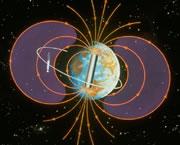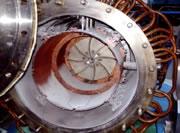 Poles apart: our planet's field flips every now and then — though no one knows why.NASA
Poles apart: our planet's field flips every now and then — though no one knows why.NASAEvery few hundred thousand years or so, the Earth's north and south magnetic poles switch places. No one knows what triggers these geomagnetic field reversals, but a team in France has now reproduced them in the lab.
Michaël Berhanu of the École Normale Supérieure in Paris and his co-workers have spun enough molten sodium to fill a small bathtub in a copper cylinder at many revolutions per second. This provided a rough simulation of the Earth's spinning core of molten iron1.
Electrical currents that are produced spontaneously in these swirling liquid metals set up a magnetic field in a process known as dynamo action. The same principles are used in industrial dynamos to create electricity, by moving metal wires through a magnetic field. Although it has been known for some time that turbulent motions in the Earth's core create the geomagnetic field this way, the details of how that happens still aren't clear.
In particular, geomagnetic reversals remain puzzling. Our magnetic poles have, in the past, faded away and then re-emerged upside down. These events are recorded in magnetic sedimentary rocks, which reveal the strength and direction of the prevailing field when it was formed. But no one knows why the reversals occurred when they did.
In a spin
To try to understand this behaviour, scientists have in the past attempted to make an artificial geodynamo in the laboratory. In 2000 they succeeded partly, when a team working at Riga in Latvia span a cylinder of molten sodium and found that it generated a magnetic field by dynamo action2. But this field stayed static — it didn't flip like the Earth's.
 Can't do this at home: not everyone has the apparatus to spin liquid metal.École Normale Supérieure
Can't do this at home: not everyone has the apparatus to spin liquid metal.École Normale SupérieureThe experiment done in France is very similar. It consists of a cylindrical chamber filled with liquid sodium that is stirred by two iron plates at each end, rotating in opposite directions. Sodium is used because it is highly electrically conducting, relatively lightweight, and melts at just 98 °C. The spinning disks make the molten metal highly turbulent, which generates a field aligned with the rotation axis of the chamber.
When the disks were spun at equal but opposite rates, this field stayed constant. But if the rotation rates were different, the behaviour was more complex, says Stéphan Fauve, group leader at the École Normale Supérieure. "This means that there is overall rotation of the entire contents," he says, "which mimics the spinning of the Earth".
Under these conditions the magnetic field switches polarity apparently at random, typically every minute or so. It happens just as it happens to the Earth, with the field declining slowly to zero and then reappearing quickly in the opposite orientation3. They find that one field orientation persists more often than the other, presumably because of a bias introduced by the Earth's magnetic field.
ADVERTISEMENT
The reversals seem to happen when the energy needed to spin the driving disks — which varies because the turbulence of the liquid produces a variable amount of friction — is lower than average.
Whereas some theories of geomagnetic reversals have postulated that they are triggered by events outside the core, such as changes in the sluggish, convective circulation of the Earth's mantle, Fauve says that their experiment shows such nudges aren't necessary to induce a reversal. "We don't need any external trigger," he says.
Visit our magneticfield_reversal.html">newsblog to read and post comments about this story.
